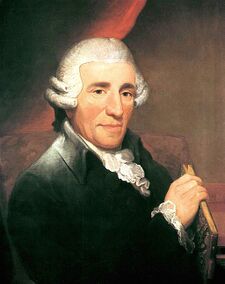Classical Period (Music)
 From Conservapedia
From Conservapedia As generally accepted by music historians, the classical period of Western music lasted from around 1750 to 1830. Since the term is easily and erroneously conflated with "classical music" (as contrasted with "popular music") some historians prefer to call the period "classic" instead.[1] Though the movement comprised composers all across continental Europe, the epicenter of activity during this time was Vienna, Austria. For this reason, other historians use the term "Viennese classic," after the German Wiener Klassik.
Strongly tied to the ideas of the Enlightenment, music of the classic period rejected the dense, polyphonic textures of Baroque music, preferring the simpler, clearer textures of homophony. In line with the true impetus behind classicism, a renewed interest in the perfect symmetry and proportions of ancient Greek art and architecture, composers in this time fully prioritized temporal balance on a small and large scale. In this regard, they adopted as a norm the symmetrical 2 or 4-measure phrase, and the well-proportioned sonata form became the preferred principle on which compositions were based.[2]
The classic period oversaw the development of many important genres of instrumental music: the symphony, the string quartet, and the piano sonata. The concerto, while inherited from the Baroque Concerto Grosso, took on a new form as a vehicle for an instrumental soloist, in most cases the composer himself. In vocal music, composers continued to write masses and other sacred music, though their importance declined. Opera began a new life in the classic period with the so-called opera buffa, or comic opera; many of the most-performed operas today were written in this style.
Development of the Classical Style[edit]

In a well-known anecdote, Joseph Haydn was discussing with Mozart his plans to travel and promote his music in London. Mozart, who unlike Haydn was fluent in several languages, expressed his incredulity that Haydn's English was good enough. Haydn famously retorted, "My language is understood throughout the world."[3]
What Haydn was referring to was the fact that by the late 18th century, at the height of the classic style, listeners and composers alike "spoke" the same musical language. As opposed to earlier styles of music, which were subject to much greater regional and stylistic variations, the classic style was a cosmopolitan lingua franca whose musical symbolism and rhetoric were understood by all. There were two main reasons for this development. First was the greater mobility of composers and musicians between the major musical centers of Paris, Vienna, and London, as well as throughout Germany, Italy, and Bohemia. This trend was reflected in the Mannheim court orchestra (see main article Mannheim School), whose members were hand-picked from among the best musicians throughout Europe. Beginning in the 1740s, the Mannheim court orchestra acted as a veritable "think tank" for developing new playing and compositional techniques, and played a large role in developing the classical style.[4]
The second factor in the classical style's pan-European nature was the faster and wider circulation of printed musical scores, which meant that a new work was often simultaneously released by several publishing houses internationally. Although Haydn had worked for most of his life in employ of the Esterhazy family whose palace was located in the far-flung sunflower fields of Eisenstadt, by his old age he had become a very famous man throughout Europe. This was purely through publication of his symphonies, as he had never been free to travel farther than Vienna until 1790. Even as far away as London, his name was already well known by the time he made his first journey there, and ensured his success in several concerts devoted to his own music.
Major classical era composers will be very well-known even to the casual listener:
- Joseph Haydn (1732-1809)
- Wolfgang Amadeus Mozart (1756-1791)
- Ludwig van Beethoven (1770-1826)
References[edit]
- ↑ Victor K. Agawu, Playing With Signs, 1987.
- ↑ Charles Rosen, The Classical Style, 1972.
- ↑ http://www.twincityjournal.eu/EN/vismo/dokumenty2.asp?id_org=600606&id=1270&p1=1008
- ↑ http://www.hoasm.org/XIIA/XIIAMannheimSchool.html
Categories: [Musical Style] [Composers]
↧ Download as ZWI file | Last modified: 02/21/2023 01:34:20 | 12 views
☰ Source: https://www.conservapedia.com/Classical_period_(music) | License: CC BY-SA 3.0
 ZWI signed:
ZWI signed: KSF
KSF